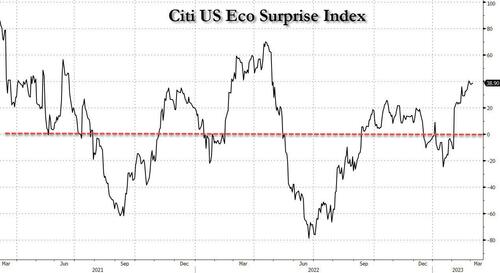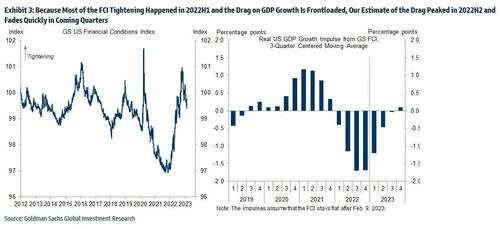By Tony Pasquariello,Goldman head of hedge fund coverage
Coming out of a week that brought a somewhat uninspiring data set, yet interesting price action ... and, headed into a very important week (payrolls, Powell and the BOJ) ... What follows from here reflects the themes that come up in client conversations.
My view in one line: rates should keep chopping higher, volatility is to be owned, and don’t get carried away on non-dollar trades.
1. While not breaking news, and at the risk of serious over-reduction, I’d describe the core macro backdrop in 2023 as follows: US inflation has been stickier-than-expected; US growth has been stronger-than-expected. To be clear, I’d stop short of describing the domestic economy as “running hot,” but the broad trend of the hard data would argue the US is generally chugging along (here I’d point you towards the recent jump in our US economic surprise index). Taken together, this invites an obvious question on whether peak rates are, once again, still in front of us -- it’s not a reach to say it, but my bet is they still are, particularly in the belly and back end.
2. The macro ecosystem I just described is NOT necessarily what many people expected as we came into the new year. Remember, the consensus view centered around a messy first half, and there was plenty of recession talk as recently as early January. On one hand, it feels like that tactical opportunity set of higher front end rates, a stronger dollar and a rip in NDX wasn’t broadly captured (and, if one made money in January, they likely gave it back in February, or vice-versa). On the other hand, there are plenty of folks still seemingly content in adding to lower-risk carry strategies ... 6-month T-bills are kicking off 5% yields right now (which now exceeds the carry on a 60/40 portfolio) and US 2-year notes are trading at levels not seen since 2007. For further reading: link.
3. I received a lot of pushback last week on my comment that I think the back end of the US rates curve is vulnerable. Here’s what I was trying to articulate (I should have just quoted Dominic Wilson directly): higher US rates along the curve is the direction of travel for now. Why? The longer we live with a 5-handle on the terminal rate ... and the US economy maintains broad momentum ... the more evidence we have that the equilibrium rate is higher ... so, the more likely it is the market contemplates seriously a 6-handle on the terminal rate ... and therefore the harder it is to believe the Fed’s ~ 2.50% assumption for the neutral rate (which, one could argue, has anchored much of the curve). related reading: link.
4. Following from there, here’s one exceedingly simple way to frame things,. starting from the perspective that I have seen a Fed Funds rate north of 6% in my (Gen-X) career:
- headline CPI, May 2000 :: 3.2%
- target Fed Funds rate, May 2000 :: 6.5%
- headline CPI, Feb 2023 :: 6.4%
- target Fed Funds rate, Feb 2023 :: 4.5%
5. Now, are there 444,000 distinctions between the global economy of today versus back then? Yes. So, one should only go so far with these compare-and-contrasts. Nonetheless, from the cheap seats, it simply feels to me like parts of the market -- and this Fed -- are still too anchored to the post-GFC world. Perhaps that’s not surprising, given that anyone who lived through the aftermath of 2008 has the experience hardwired into their DNA, but my point is this: shouldn’t we be increasingly open-minded to the argument that the post-GFC years were more an exception than a lasting new normal?
6. In that spirit, again I find the Jason Furman content on Twitter to be, if nothing else, cause for contemplation: “the economy is very overheated ... we have made little if any progress on inflation ... there is little if any reason to expect a large slowdown going forward ... a wide range of measures of ‘underlying’ inflation are telling the same story ... supply chains unfreezing were supposed to bring down inflation, they didn’t ... 6% inflation is much more likely than 2%.” I come out somewhere in-between his angle (link) our forecasts (link), with the ongoing intuition that inflation won’t magically disappear when the labor market is this tight. Related, I also admit that I’m surprised that breakevens took so long to get going again.
7. A few additional takes on things from an informal exchange I had with Dominic Wilson in GIR:
- i. I think Furman is overdoing it.
- ii. I think the big near-term risk here is if the Fed opens up 50s. If they don’t, I suspect markets can manage it. If they do, we aren’t priced for it. That’s overly reductive, but I think that’s the basic risk here.
- iii. Near-term volatility pricing in lots of places looks too low given the event risk. In under 3 weeks we get payrolls, US CPI, Powell, BOJ, ECB, Fed, BoE, China activity data and their Two Sessions policy meetings. That data set could set us on potentially very different paths, but vol overall isn’t particularly high given this event risk in many places (Chinese equities; EUR; major DM indices) and there are pockets of vol (Topix with an 11-handle) that are low even on a long history. Options look cheap.
8. A few additional takes on the week from an informal exchange I had with Mike Cahill in GIR:
- i. The market pricing of 31 bps for the March FOMC (that will settle at 25 or 50 bps) is not a stable equilibrium. Rather than quiet markets in a quiet week, it’s been jumpy markets clinging to every little piece of news (e.g. I haven’t seen Fed Funds respond to a durable goods report in a while).
- ii. The global coordination is a clear difference between now and most of 2022, when US exceptionalism ruled the day and Europe and China were mired down with wars of their own. That makes things a lot trickier in FX land, but it probably all pushes in the same direction for rates.
- iii. Markets spent February mostly reversing the trends and narratives in January, so we’re close to unchanged since mid-Dec / early-Jan on a number of major asset classes. But, one key thing hasn’t changed -- as of now, the Fed is still locked into the 2-3 x 25 bps hikes pace that it established at the start of February. Maybe they will say that things are still broadly on track, but that deserves a mention if you’re making a list of things that haven’t yet corrected for January’s exuberance.
- iv. As it relates to point #3 up top on the neutral Fed Funds rate: so we’ve had (potentially) two distinct cycles: a too-low reading from 2012-2019 (the funds rate is low but the economy is weak -- the neutral must be low) and a much higher reading now (we’ve hiked a lot but the economy hasn’t slowed -- neutral must be high). Maybe the real answer though is that the economy, especially post-2008 housing crash, isn’t all that responsive to the funds rate.
9. I still believe this is our most important, if distinct house view: “there appears to be some confusion about the phrase ‘long and variable lags,’ which actually referred to the time until the peak impact on the level of GDP, not the peak impact on the growth rate of GDP. all prominent macroeconomic models that we are aware of agree with our FCI growth impulse model that the peak drag on GDP growth is frontloaded. these points explain why our estimate of the drag on GDP growth from the tightening in financial conditions last year peaked in 2022H2 and fades fairly quickly in 2023.” see exhibit 3, link.
10. Switching gears a bit: I’m normally of the view that geopolitics are exceptionally difficult variables to consistently trade, and after the initial shock and shakeout, markets usually surprise in their ability to find coping mechanisms and become inured to the nightly news. That said, it feels to me like geopolitical tension is rising significantly right now -- with growing risk of miscalculation -- to an extent that seems greater than what I encounter in client dialogue. I further admit I’m not totally sure what to do with this, particularly given my bias on interest rates, but it underscores Dominic’s take on the attractiveness of vol.
11. Perhaps relevant to that last point: Europe has been the fastest horse in the global equity race this year, and it really hasn’t been close. Alongside ongoing structural issues, the formal start of ECB QT and higher-than-expected inflation that’s lengthening the string of 50 bps rate hikes (we added another this week) I can easily see a scenario where a return of geopolitical worries knocks the momentum off course. so, even as someone who respects the local draw of cheap relative valuation and a cyclical-heavy index, count me as skeptical that SX5E can hold this pace for the rest of the year.
12. As noted previously, the month of January saw record hedge fund buying of Chinese equities (this via GS PB data, link). Price action since then -- across the entire China complex, including credit and commodities -- was disappointing (until this week’s PMI boom, anyway). Looking forward, the big flow-of-funds question is this: What will strategic real money do with the Chinese equity market? I’m inclined to believe they will be reticent to commit until the shareholder challenges of 2021 are long past us, which makes me worry about lasting and significant sponsorship (this may explain poor price action following decent earnings).
13. A non-sequitur: our industry devotes too much ink to the activity of the CTA community. While admitting that I’m guilty of referencing this crowd, remember this level set: CTAs comprise about 8% of total hedge fund assets ... in S&P futures, about 6% of total open interest ... and -- at peak activity -- around 4% of daily volume (thanks to Paul Leyzerovich for the data). I’m not saying that CTAs don’t matter -- they do, and their footprint can be epically important at occasional market inflection points -- I’m simply saying they get outsized attention relative to other market actors and fundamental forces.
14. In the context of higher interest rates, this note is a high quality check-down of some clear trends that are taking shape beneath the equity hood - for example, cyclical industrials and inflation winners/losers are doing what they should: link.
15. Finally, the annual Berkshire Hathaway letter is worth the quick read: link. I reckon there’s a bit of wisdom in here:
thus began our journey to 2023, a bumpy road involving a combination of continuous savings by our owners (that is, by their retaining earnings), the power of compounding, our avoidance of major mistakes and -- most important of all -- the American Tailwind ... our satisfactory results have been the product of about a dozen truly good decisions — that would be about one every five years — and a sometimes-forgotten advantage that favors long-term investors.
https://www.zerohedge.com/markets/goldman-big-near-rerm-risk-here-if-fed-opens-50s


No comments:
Post a Comment
Note: Only a member of this blog may post a comment.